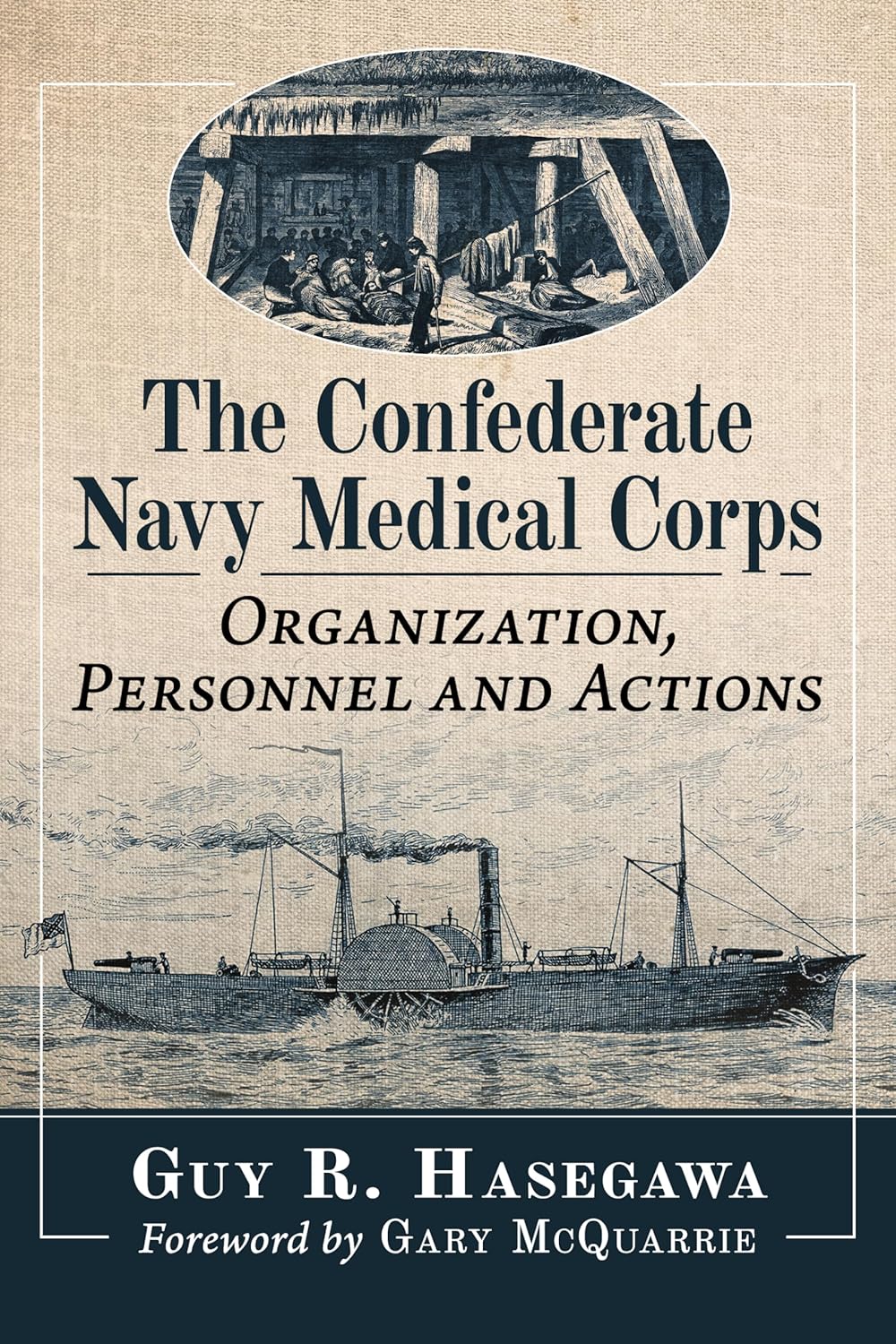Book Review: The Confederate Navy Medical Corps: Organization, Personnel and Actions

 The Confederate Navy Medical Corps: Organization, Personnel and Actions. By Guy R. Hasegawa. Jefferson, NC: McFarland and Company. Softcover, 239 pp. $39.95.
The Confederate Navy Medical Corps: Organization, Personnel and Actions. By Guy R. Hasegawa. Jefferson, NC: McFarland and Company. Softcover, 239 pp. $39.95.
Reviewed by Michael C. Hardy
When the Confederate government came into being in 1861, it had no army, no navy, no financial system, no legal system. What it did have was a preexisting structure to build upon. The US Constitution was refined, and the US Army Regulations were adopted. Likewise, the Confederate Navy had eighty years of precedent for the framework for its own nautical force. The nascent Confederate Navy was quick to adopt the organizational outlines of the United States Navy. It saved an enormous amount of time, and since Confederate naval officers were for the most part former US naval officers, there was a large degree of familiarity. The new government was quick to appoint these experienced officers to positions of leadership within the new navy. It was not just administrative offices that needed to be filled. There were naval stations on shore, mostly in port cities, plus vessels afloat that needed surgeons and assistants to care for the wounded and the diseased.
Despite the numerous gaps in surviving records, Guy R. Hasegawa, in his newest release, The Confederate Navy Medical Corps: Organization, Personnel and Actions, dives deeply into an unexplored aspect of Confederate and Civil War historiography. Hasegawa starts at the beginning, as the provisional Confederate Congress in Montgomery established the Navy Department. This chapter and the following chapter titled “Building a Nucleus” are the most technical in the book. Various medical officers pass through the text as they resign from the old Navy and are commissioned in Confederate service. The Office of Medicine and Surgery is established, with Surgeon William A. W. Spotswood as chief.
There was always a desire to recruit more surgeons and assistant surgeons, although for a time, there were more trained medical professionals than there were ships or shore bases for them to serve on. Each medical professional had to pass tests issued by a board or had to be in service for a certain number of years to advance to the next grade. As with the Confederate Army, the Confederate Navy could hire contract surgeons or doctors if needed. And while the Confederate Navy often had its own shore hospitals, they could use army or civilian hospitals if the need arose.
The real bulk of Hasegawa’s contribution comes in the chapters after the establishment of the Office of Medicine and Surgery and the cadre of surgeons and support staff. There are chapters on surgeons on duty while stationed on ships, medical purveying, the numerous shore-based hospitals (like those in Charleston, Richmond, and Wilmington), medical officers on court and examination boards, along with the treatment of the sick and wounded. In the latter chapter, rosters of various ships are examined, while various diseases are scrutinized, like malaria, yellow fever, and scurvy, along with sexually transmitted diseases. Hasegawa found that syphilis was more common than gonorrhea. He goes on to examine the treatment available to doctors at the time, along with case studies of various diseased sailors when possible. Hasegawa then includes information on naval medical personnel who were involved in expeditions and raids and other assignments, along with the surgeons at the end of the war.
“The loss and dispersal of Confederate records at the end of the Civil War have made it difficult to form a complete picture of how the [Confederate State Navy’s] medical department operated,” concludes Hasegawa. (182) Some of those records were destroyed as Richmond fell, while others were transported to Charlotte, where they disappeared. Despite this regrettable loss of records. Hasegawa has done an admirable job of filling in the pieces of the Confederate States’ Navy, looking at both the administrative and field work performed by a small band of highly trained individuals. Works on various aspects of the Confederate medical program are few. Hasegawa’s The Confederate Navy Medical Corps deserves a place right beside that of H. H. Cunningham’s Doctors in Gray: The Confederate Medical Service (LSU Press, 1993).
Michael C. Hardy is an award-winning and widely published author. A graduate of the University of Alabama, he has written on a large array of subjects — Confederate regimentals, Southern places, and personalities — in twenty-six books, numerous articles, and over one thousand blog posts. In 2010, Hardy was named North Carolina Historian of the Year by the North Carolina Society of Historians. He was also awarded the James I. Robertson Literary Prize by the Robert E. Lee Civil War Library and Research Center in 2018 for his history of the Branch-Lane Brigade, General Lee’s Immortals (Savas Beatie, 2018). When not researching, writing, and traveling, he volunteers at historic sites, sharing his love for history.
Michael Hardy is an extraordinary historian – he’s from my neck of the woods and has documented local histories to a fine point, as well as his significant work on the Civil War. Congratulations on featuring his latest on your blog page.